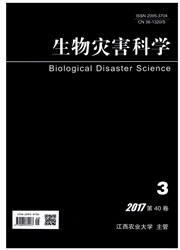

 中文摘要:
中文摘要:
研究不同浓度城市污水暴露对食蚊鱼(Gambusia affinis)的形态雌/雄性化生物学效应,以探讨筛选监测水环境内分泌干扰物污染的敏感生物标志物。分别将雌、雄性食蚊鱼个体分别暴露于含10%、40%、60%和80%樟村污水处理厂出水原液不同浓度的实验组中,并设置对照组和平行组。持续暴露35 d后观察与测定食蚊鱼椎肋骨发育及臀鳍条的形态变异状况,以及定量测定雄鱼肝脏卵黄蛋白原基因(VTGα)和雌激素受体基因(ERα)m RNA转录水平、雌鱼臀鳍雄激素受体基因(ARα)m RNA转录水平。结果显示,雌性食蚊鱼第14/15/16根椎肋骨出现增生,臀鳍ARαm RNA转录水平相应明显升高,表明雌鱼雄性化逆转明显;雄鱼肝脏VTGαm RNA转录水平显著升高,并且其升高趋势与暴露浓度相一致,表明雄鱼雌性化明显。室内模拟实验结果表明,东莞城市废水中存在能致食蚊鱼发生雌/雄激素效应的内分泌干扰物质,食蚊鱼其骨骼形态及目标基因表达变化适合作为监测水环境内分泌干扰物污染的生物标志物。
 英文摘要:
英文摘要:
The aim of this study was to investigate the feminizing/masculinizing effects of urban sewage exposure at different concentrations on the morphology of mosquito-fish(Gambusia affinis), in order to screen the sensitive biomarkers to monitor the environmental endocrine disruptors pollution in waters. Female and male mosquito-fish individuals were put into static water with 10%, 40%, 60% and 80% of urban sewage, respectively. In addition, control group and parallel groups were set up. After 35-day-long exposure, we measured the morphological changes in the anal fin and the 14, 15 and 16 vertebral ribs. We also determined the m RNA expression levels of vitellogenin gene(VTGα), estrogen receptor gene(ERα) in male livers, and androgen receptor gene(ARα) in female anal. The results showed that, with a hyperosteogeny in 14 th, 15 th and 16 th female spines and increase in anal fin ARα m RNA transcription level of the 35-day-long exposed female mosquito-fish, the androgenic effects in the aquatic environment of the urban sewage was testified. An increased hepatic VTGαm RNA transcription level was also detected in the exposed male mosquito-fish, indicating the estrogenic effects induced by sewage treatment effluents. Laboratory simulation results showed that, there are some endocrine disruptor substances inducing the estrogen/androgen effects on mosquito-fish in Dongguan City's wastewater, and again, the changes of bone morphology and target gene expression in mosquito-fish could act as sensitive biomarkers to monitor the environmental endocrine disruptor pollution in waters.
 同期刊论文项目
同期刊论文项目
 同项目期刊论文
同项目期刊论文
 期刊信息
期刊信息
